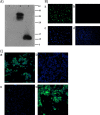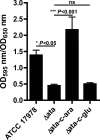Identification of Ata, a multifunctional trimeric autotransporter of Acinetobacter baumannii
- PMID: 22609912
- PMCID: PMC3416510
- DOI: 10.1128/JB.06769-11
Identification of Ata, a multifunctional trimeric autotransporter of Acinetobacter baumannii
Abstract
Acinetobacter baumannii has recently emerged as a highly troublesome nosocomial pathogen, especially in patients in intensive care units and in those undergoing mechanical ventilation. We have identified a surface protein adhesin of A. baumannii, designated the Acinetobacter trimeric autotransporter (Ata), that contains all of the typical features of trimeric autotransporters (TA), including a long signal peptide followed by an N-terminal, surface-exposed passenger domain and a C-terminal domain encoding 4 β-strands. To demonstrate that Ata encoded a TA, we created a fusion protein in which we replaced the entire passenger domain of Ata with the epitope tag V5, which can be tracked with specific monoclonal antibodies, and demonstrated that the C-terminal 101 amino acids of Ata were capable of exporting the heterologous V5 tag to the surface of A. baumannii in a trimeric form. We found that Ata played a role in biofilm formation and bound to various extracellular matrix/basal membrane (ECM/BM) components, including collagen types I, III, IV, and V and laminin. Moreover, Ata mediated the adhesion of whole A. baumannii cells to immobilized collagen type IV and played a role in the survival of A. baumannii in a lethal model of systemic infection in immunocompetent mice. Taken together, these results reveal that Ata is a TA of A. baumannii involved in virulence, including biofilm formation, binding to ECM/BM proteins, mediating the adhesion of A. baumannii cells to collagen type IV, and contributing to the survival of A. baumannii in a mouse model of lethal infection.
Figures






References
-
- American Association for Pediatrics 2006. Pertussis (whooping cough). Red Book Online 2006:498–520
-
- Bendtsen JD, Nielsen H, von Heijne G, Brunak S. 2004. Improved prediction of signal peptides: SignalP 3.0. J. Mol. Biol. 340:783–795 - PubMed
-
- Bradford MM. 1976. A rapid and sensitive method for the quantitation of microgram quantities of protein utilizing the principle of protein-dye binding. Anal. Biochem. 72:248–254 - PubMed
Publication types
MeSH terms
Substances
Associated data
- Actions
Grants and funding
LinkOut - more resources
Full Text Sources
Other Literature Sources
Molecular Biology Databases
Research Materials

